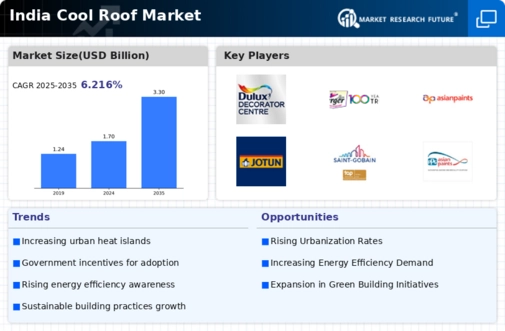Rising Energy Costs
The escalating costs of energy in India are prompting building owners to seek more efficient solutions to manage their energy consumption. With electricity prices rising, particularly during peak summer months, the cool roof market is gaining traction as a viable alternative. Cool roofs can significantly reduce the need for air conditioning by reflecting sunlight and absorbing less heat, which can lead to energy savings of 20-30%. This reduction in energy demand not only lowers utility bills but also contributes to a decrease in greenhouse gas emissions. As energy costs continue to rise, the cool roof market is likely to see increased adoption among residential and commercial properties, as stakeholders recognize the long-term financial and environmental benefits of investing in energy-efficient roofing solutions.
Growing Construction Sector
India's construction sector is experiencing robust growth, driven by urbanization and infrastructure development. This expansion presents a significant opportunity for the cool roof market, as new buildings are increasingly being designed with energy efficiency in mind. The demand for cool roofing materials is likely to rise as architects and builders seek to comply with energy efficiency standards and enhance the sustainability of their projects. According to recent estimates, the construction sector is projected to grow at a CAGR of 7-8% over the next few years. This growth will likely lead to a higher adoption rate of cool roofs, as stakeholders recognize the benefits of reducing heat absorption and improving energy efficiency in new constructions.
Increasing Urban Heat Island Effect
The urban heat island effect is becoming increasingly pronounced in Indian cities, leading to higher ambient temperatures. This phenomenon occurs when urban areas experience significantly warmer temperatures than their rural surroundings due to human activities and infrastructure. As cities expand, the demand for solutions to mitigate heat becomes critical. The cool roof market is poised to benefit from this trend, as reflective roofing materials can help reduce heat absorption, thereby lowering indoor temperatures. Studies indicate that implementing cool roofs can decrease surface temperatures by up to 5-10 degrees Celsius, which is particularly beneficial in densely populated areas. This growing awareness of the urban heat island effect is driving the adoption of cool roofing solutions, as municipalities and building owners seek to create more comfortable living environments while also addressing climate change concerns.
Consumer Demand for Eco-Friendly Solutions
There is a noticeable shift in consumer preferences towards eco-friendly and sustainable building materials in India. As awareness of environmental issues grows, more homeowners and businesses are seeking solutions that minimize their ecological footprint. The cool roof market is well-positioned to capitalize on this trend, as cool roofs not only enhance energy efficiency but also contribute to reducing urban heat. Consumers are increasingly inclined to invest in roofing solutions that align with their values of sustainability and environmental responsibility. This growing demand for eco-friendly solutions is likely to drive innovation and competition within the cool roof market, as manufacturers strive to develop more effective and sustainable roofing materials.
Government Initiatives for Sustainable Development
The Indian government is actively promoting sustainable development through various initiatives aimed at reducing energy consumption and enhancing urban resilience. Programs such as the Smart Cities Mission and the National Mission for Sustainable Habitat encourage the adoption of energy-efficient technologies, including cool roofs. These initiatives often provide financial incentives and technical support to encourage the implementation of cool roofing solutions. The cool roof market is expected to benefit from these government policies, as they align with national goals to reduce carbon emissions and improve urban living conditions. Furthermore, the government's commitment to achieving a 33-35% reduction in emissions intensity by 2030 under the Paris Agreement underscores the importance of adopting innovative solutions like cool roofs to meet these targets.




















Leave a Comment